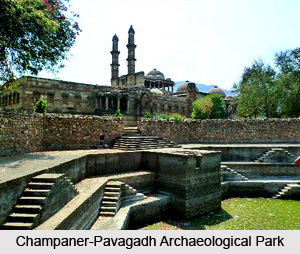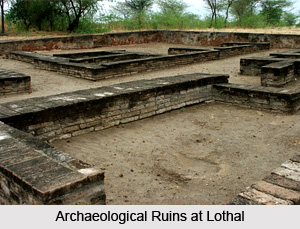 Archaeological sites in Gujarat can be traced back to the ancient and pre-historic ages, during the era of the Mahabharata, Vedic Age and the age of the renowned Indus Valley Civilization. Gujarat, which is the birthplace of Mahatma Gandhi is home to a large variety of historical regions, which have revealed rare specimens of bygone civilizations through the numerous excavations conducted here. Thousands of tourists crowd Gujarat to witness these exquisite archaeological sites. Gujarat possesses many `heritage spots`, which boasts of archaeological marvels, like Rani ki Vav at Patan, Adalaj, Dada Hari Ni Vav at Ahmedabad and so on. Various organizations like State Archaeology, Archaeological Survey of India, several universities and other research bodies have supervised numerable excavations conducted here.
Archaeological sites in Gujarat can be traced back to the ancient and pre-historic ages, during the era of the Mahabharata, Vedic Age and the age of the renowned Indus Valley Civilization. Gujarat, which is the birthplace of Mahatma Gandhi is home to a large variety of historical regions, which have revealed rare specimens of bygone civilizations through the numerous excavations conducted here. Thousands of tourists crowd Gujarat to witness these exquisite archaeological sites. Gujarat possesses many `heritage spots`, which boasts of archaeological marvels, like Rani ki Vav at Patan, Adalaj, Dada Hari Ni Vav at Ahmedabad and so on. Various organizations like State Archaeology, Archaeological Survey of India, several universities and other research bodies have supervised numerable excavations conducted here.
Archaeological Site of Lothal
Lothal is a crucial hub of the Indus Valley Civilization and it is present in Bhal, and it can be dated back to 2400 BCE. It was discovered in the year 1954. The term `Lothal` implies to the `mound of the dead`, just as the region of Mohen-jo-Daro, which also means the same, as per the Sindhi language. Evidences of old towns and human remnants have been unearthed from places in Lothal. Excavations conducted here have uncovered red-ware belonging to the pre-Harappan era, and two periods between 1900 BCE and 2400 BCE have indicated the existence of civilizations of Harappa and Mohen-jo-Daro.
Archaeological Site of Rangpur
Rangpur is located between the Gulf of Kutch and the Gulf of Khambhat, especially on the north-western site of Lothal. The Archaeological Survey of India or ASI has carried out trail diggings during 1935. Red-ware, black-ware, dishes decorated with beaded rims, long-necked jars, shell crafts and a vast number of plant remnants have been discovered at Rangpur. Millets, bajra, rice are some of the other items uncovered.
Archaeological Site of Oriyo Timbo
The site of Oriyo Timbo in Bhavnagar District is a significant archaeological region which occupies an area of 4 hectares and is present at about 70 km from Rojdi, which is yet another site of Indus Valley Civilization. University Museum of University of Pennsylvania and Gujarat State Department of Archaeology are the organizations which were responsible for the excavations conducted here. Radio carbon dates which can be traced to 3700 BC circa.
Archaeological Site of Bhagatrav
 Bhagatrav is an interesting archaeological site which contains remnants of Indus Valley Civilization, particularly some Harappan settlements of which involve Chanhu-Daro, Rangpur, Desalpur, etc. Excavations have been carried out by the Archaeological Survey of India. It is located in Hansot in the district of Bharuch, in the southern portion of Gujarat. It is said that Bhagatrav is amongst the southern-most settlements of Harrapan age.
Bhagatrav is an interesting archaeological site which contains remnants of Indus Valley Civilization, particularly some Harappan settlements of which involve Chanhu-Daro, Rangpur, Desalpur, etc. Excavations have been carried out by the Archaeological Survey of India. It is located in Hansot in the district of Bharuch, in the southern portion of Gujarat. It is said that Bhagatrav is amongst the southern-most settlements of Harrapan age.
Champaner-Pavagadh Archaeological Park
Situated in Panchmahal District, Champaner-Pavagadh Archaeological Park is a UNESCO World Heritage Site which was built by Gujarat`s Sultan Mahmud Begada. Heritage monuments and beautiful forts dot the landscape of this park. Ruins belonging to the 16th century and Chalcolithic sites fill up this region. Temples, tombs, arches, mosques, palaces, tanks and stepwells are some of the impressive archaeological structures. Architectural patterns followed by Muslims and Hindus, which were common in 15th and 16th century are manifested through the historical monuments of this park.
Archaeological Site of Dholavira
Dholavira exists in Bhachau Taluka of Kutch District, which has been named after a village which is based about 1 km away from it. This area is at a distance of nearly 165 km from Radhanpur. Remains of Indus Valley Civilization and Harappa can be noticed. Dholavira was inhabited from 2650 BCE and continued to be populated till 1450 BCE. Since the year 1990, this area is being excavated by the Archaeological Survey of India which has brought to light the existence of terracotta jewelleries, seals, pottery -ware, bronze containers, animal bones, silver, gold and many other artefacts.
Archaeological Site of Shikarpur
Excavations at Shikarpur village in Gujarat bear testimony to the survival of Harappan settlements and Indus Valley Civilization, which extends over an area of 3.4 hectares. Copper chisels, terracotta and steatite objects, animal figurines, knives, bangles manufactured from shells, semi precious gemstones, rings and a human torso. Toys made from terracotta, conch-shell bangles, miniature pots, carnelian drill-bits, gold beads, images of bulls are some of the numerous artefacts dug out from Shikarpur.
Other Archaeological Sites of Gujarat
There are several other famous archaeological sites in the western Indian state of Gujarat which include Babar Kot, Desalpur, Dwarka, Gola Dhoro, Ghumli, Kerala-no-Dhoro, Kuntasi, Loteshwar, Malwan, Pabumath, Prabhas Pathan, Rojdi, Sarkhej, Sarkhej Roja and Surkotada.






































